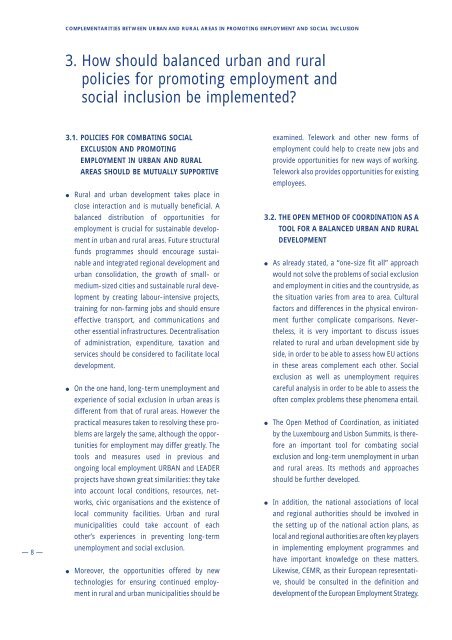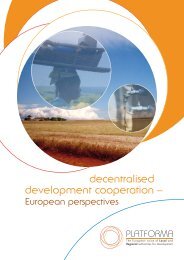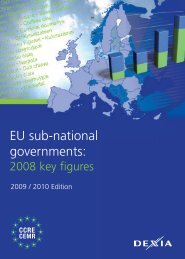Complementarities between urban and rural areas in promoting ...
Complementarities between urban and rural areas in promoting ...
Complementarities between urban and rural areas in promoting ...
Create successful ePaper yourself
Turn your PDF publications into a flip-book with our unique Google optimized e-Paper software.
COMPLEMENTARITIES BETWEEN URBAN AND RURAL AREAS IN PROMOTING EMPLOYMENT AND SOCIAL INCLUSION3. How should balanced <strong>urban</strong> <strong>and</strong> <strong>rural</strong>policies for promot<strong>in</strong>g employment <strong>and</strong>social <strong>in</strong>clusion be implemented?— 8 —3.1. POLICIES FOR COMBATING SOCIALEXCLUSION AND PROMOTINGEMPLOYMENT IN URBAN AND RURALAREAS SHOULD BE MUTUALLY SUPPORTIVE●●●Rural <strong>and</strong> <strong>urban</strong> development takes place <strong>in</strong>close <strong>in</strong>teraction <strong>and</strong> is mutually beneficial. Abalanced distribution of opportunities foremployment is crucial for susta<strong>in</strong>able development<strong>in</strong> <strong>urban</strong> <strong>and</strong> <strong>rural</strong> <strong>areas</strong>. Future structuralfunds programmes should encourage susta<strong>in</strong>able<strong>and</strong> <strong>in</strong>tegrated regional development <strong>and</strong><strong>urban</strong> consolidation, the growth of small- ormedium-sized cities <strong>and</strong> susta<strong>in</strong>able <strong>rural</strong> developmentby creat<strong>in</strong>g labour-<strong>in</strong>tensive projects,tra<strong>in</strong><strong>in</strong>g for non-farm<strong>in</strong>g jobs <strong>and</strong> should ensureeffective transport, <strong>and</strong> communications <strong>and</strong>other essential <strong>in</strong>frastructures. Decentralisationof adm<strong>in</strong>istration, expenditure, taxation <strong>and</strong>services should be considered to facilitate localdevelopment.On the one h<strong>and</strong>, long-term unemployment <strong>and</strong>experience of social exclusion <strong>in</strong> <strong>urban</strong> <strong>areas</strong> isdifferent from that of <strong>rural</strong> <strong>areas</strong>. However thepractical measures taken to resolv<strong>in</strong>g these problemsare largely the same, although the opportunitiesfor employment may differ greatly. Thetools <strong>and</strong> measures used <strong>in</strong> previous <strong>and</strong>ongo<strong>in</strong>g local employment URBAN <strong>and</strong> LEADERprojects have shown great similarities: they take<strong>in</strong>to account local conditions, resources, networks,civic organisations <strong>and</strong> the existence oflocal community facilities. Urban <strong>and</strong> <strong>rural</strong>municipalities could take account of eachother’s experiences <strong>in</strong> prevent<strong>in</strong>g long-termunemployment <strong>and</strong> social exclusion.Moreover, the opportunities offered by newtechnologies for ensur<strong>in</strong>g cont<strong>in</strong>ued employment<strong>in</strong> <strong>rural</strong> <strong>and</strong> <strong>urban</strong> municipalities should beexam<strong>in</strong>ed. Telework <strong>and</strong> other new forms ofemployment could help to create new jobs <strong>and</strong>provide opportunities for new ways of work<strong>in</strong>g.Telework also provides opportunities for exist<strong>in</strong>gemployees.3.2. THE OPEN METHOD OF COORDINATION AS ATOOL FOR A BALANCED URBAN AND RURALDEVELOPMENT●●●As already stated, a “one-size fit all” approachwould not solve the problems of social exclusion<strong>and</strong> employment <strong>in</strong> cities <strong>and</strong> the countryside, asthe situation varies from area to area. Culturalfactors <strong>and</strong> differences <strong>in</strong> the physical environmentfurther complicate comparisons. Nevertheless,it is very important to discuss issuesrelated to <strong>rural</strong> <strong>and</strong> <strong>urban</strong> development side byside, <strong>in</strong> order to be able to assess how EU actions<strong>in</strong> these <strong>areas</strong> complement each other. Socialexclusion as well as unemployment requirescareful analysis <strong>in</strong> order to be able to assess theoften complex problems these phenomena entail.The Open Method of Coord<strong>in</strong>ation, as <strong>in</strong>itiatedby the Luxembourg <strong>and</strong> Lisbon Summits, is thereforean important tool for combat<strong>in</strong>g socialexclusion <strong>and</strong> long-term unemployment <strong>in</strong> <strong>urban</strong><strong>and</strong> <strong>rural</strong> <strong>areas</strong>. Its methods <strong>and</strong> approachesshould be further developed.In addition, the national associations of local<strong>and</strong> regional authorities should be <strong>in</strong>volved <strong>in</strong>the sett<strong>in</strong>g up of the national action plans, aslocal <strong>and</strong> regional authorities are often key players<strong>in</strong> implement<strong>in</strong>g employment programmes <strong>and</strong>have important knowledge on these matters.Likewise, CEMR, as their European representative,should be consulted <strong>in</strong> the def<strong>in</strong>ition <strong>and</strong>development of the European Employment Strategy.














![[ ] Les jumelages pour le monde de demain](https://img.yumpu.com/29721946/1/190x96/-les-jumelages-pour-le-monde-de-demain.jpg?quality=85)

